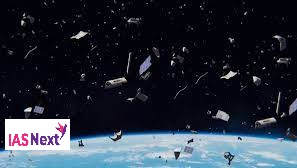CURRENT AFFAIRS
Get the most updated and recent current affair content on Padhaikaro.com
Satellites for Space debris
- IAS NEXT, Lucknow
- 22, Jan 2022

Reference News:-
Russia blew up one of its old satellites in November in a missile test that sparked international anger because of the space debris it scattered around the Earth’s orbit.
- Recently, a Chinese satellite (Tsinghua Science Satellite) had a near collision with one of the many chunks of debris left by the fallout of this Russian anti-satellite missile test.
What’s the issue?
With more countries venturing into space with every passing decade, the problem is simply ballooning out of control and recent events, like the anti-satellite weapons test by Russia, are only exacerbating the problem.
- The debris is now adding to the space junk problem and posing a major risk to the International Space Station (ISS) and the satellites in geostationary orbit.
- The debris also poses a potential threat to the lives of the US, Russian, and Chinese astronauts and cosmonauts currently in space.
What is Space Debris?
Space debris poses a global threat to the continued use of space-based technologies that support critical functions like communication, transport, weather and climate monitoring, remote sensing.
- Predicting collision probability from these space objects is crucial from the national security perspective as well as for the protection of public and private space assets of Indian origin.
Amount of space debris in space:
The real amount of space debris is said to be between 500,000 and one million pieces as current sensor technology cannot detect smaller objects. They all travel at speeds of up to 17,500 mph (28,162 kmph) fast enough for a relatively small piece of orbital debris to damage a satellite or a spacecraft.
Significance of the Project:
Outcome of this project will directly support the Indian space sector, valued at $7 billion (Rs 51,334 crore) by providing an operationally flexible, scalable, transparent and indigenous collision probability solution.
Technologies that can tackle the problem in future are:
Moving an object out of the way by altering its orbit is one method of diverting a potential crash, but the sheer amount of debris requires constant observation and prediction – by any means necessary.
Nasa’s Space Debris Sensor orbits the Earth on the International Space Station. The sensor was attached to the outside of the space station’s European Columbus module in December 2017. It will detect millimetre-sized pieces of debris for at least two years, providing information on whatever hits it such as size, density, velocity, orbit and will determine whether the impacting object is from space or a man-made piece of space debris.
REMOVEdebris, satellite contain two cubesats that will release simulated space debris so that it can then demonstrate several ways of retrieving them.
Deorbit mission: There are two emerging technologies being developed under what’s known as the e.Deorbit mission to grasp the wayward space junk, or to catch it.
Other technologies include moving objects with a powerful laser beam. It is important to start doing that soon, current scientific estimates predict that without active debris removal, certain orbits will become unusable over the coming decades.
Netra:
To safeguard its space assets from space debris, Isro had set up a dedicated Space Situational Awareness (SSA) Control Centre named “Netra” in Bengaluru last December.
- Netra’s key objective is to monitor, track and protect the national space assets and function as a hub of all SSA activities.
- Only the US, Russia and Europe have similar facilities in place to track space objects and share collision warnings.
India’s Anti-Satellite (ASAT) missile:
Mission Shakti is a joint programme of the Defence Research and Development Organisation (DRDO) and the Indian Space Research Organisation (ISRO).
- As part of the mission, an anti-satellite (A-SAT) weapon was launched and targeted an Indian satellite which had been decommissioned. Mission Shakti was carried out from DRDO’s testing range in Odisha’s Balasore.
Significance:
India is only the 4th country to acquire such a specialised and modern capability, and Entire effort is indigenous. Till now, only the US, Russia and China had the capability to hit a live target in space.